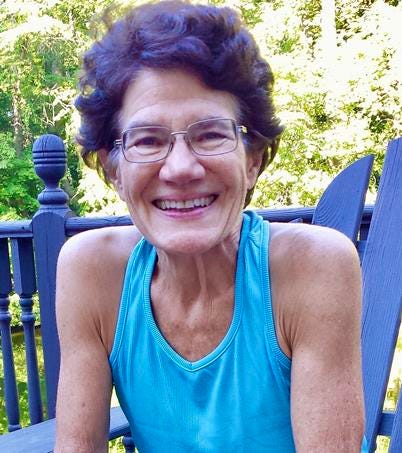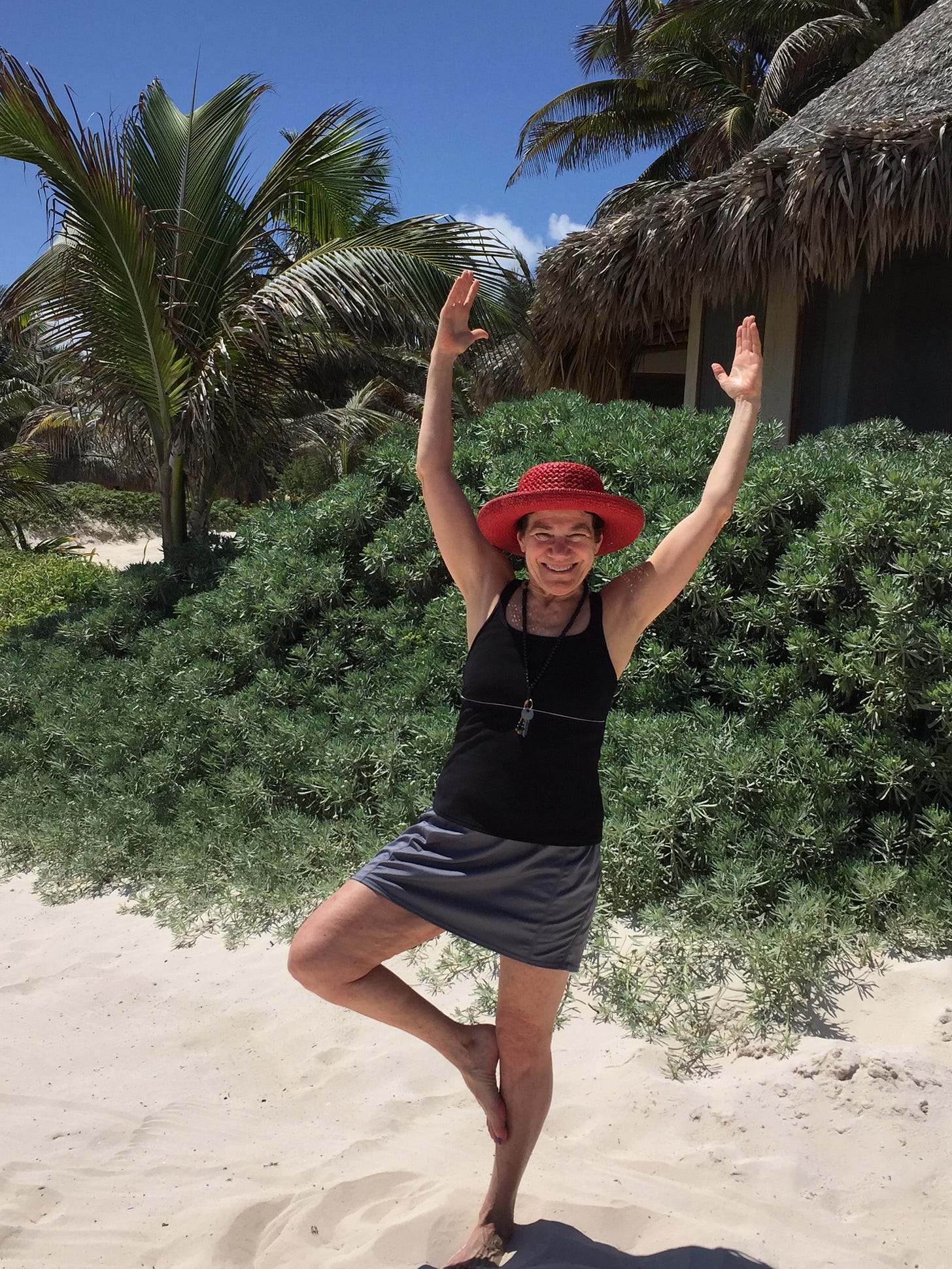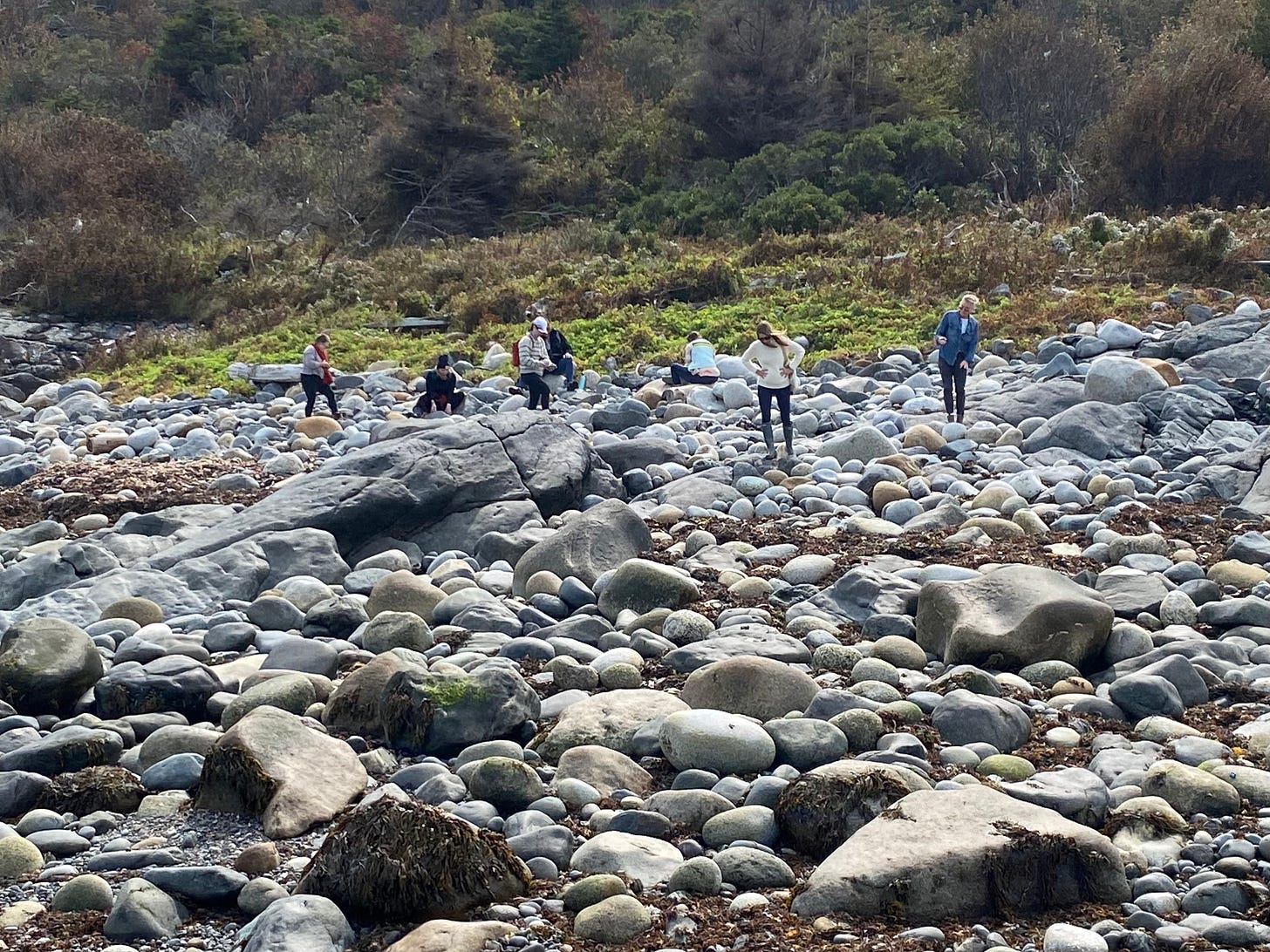In conversation with Margaret Mandell
sewing stories, from mat to page
Welcome to narrative threads: from breath to pen. If you’re new, I’m so glad you’re here!
Today’s post is a pause from my regular musings—the second in an occasional conversation between myself and other writers.
I’m delighted to introduce you to Margaret Mandell, author of her first memoir, And Always One More Time, not to mention my twin separated at birth.
Peggy and I met in 2019 at a yoga + writing retreat in Tulum, MX, where I was an assistant and she was a participant. Both of us were beginning new chapters in our respective lives. I was returning to the studio where I had taken my first class almost twenty years prior, now in the seat of the teacher. Peggy was finishing a collection of letters she had started writing after the passing of her husband, a daily practice that had come to fill ten journals. We were both involved in new relationships with men named John.
It’s been my honor to know Peggy, so come along as we explore the intertwined relationship between yoga and writing and how both practices have guided us into becoming the women we have always been. From breath to pen, mat to page.
Margaret Mandell’s life story is one of adaptation. Earning her BA and MA in History at the University of Pennsylvania, she has been a doctoral candidate and college teacher, mother of two, entrepreneur, independent school admissions director, triathlete, and certified yoga instructor. When her husband of many years passed away, she became a widow, a woman still in the midst of becoming. Her debut memoir And Always One More Time, released by Atmosphere Press, tells the story of her next act and new, sustaining love. Excerpts have appeared in The Metaworker, Brevity Blog, NextTribe, Oldster, and the Daring to Tell podcast. To learn more about Margaret, go to her website.
Ever since childhood, you have been told and considered yourself to be a writer. Yet publishing a memoir and sharing what may have begun as words written to oneself for oneself is profoundly different.
As a child, I was told I could “turn a phrase,” I loved playing with language and began writing songs, poems, and keeping diaries from the time I could write. I loved the musicality of words and the way they conveyed humor, irony, and, above all, storytelling.
It was a short leap to letter-writing, especially when I was sent away to summer camp. There, I soothed away homesickness with painstakingly detailed letters to my parents, discovering that letters connect us to the people we miss.
I did not know I was practicing for the letters I would someday write to Herb, my happily-ever-after husband of 45 years, who would vanish the day after my 65th birthday, suffocating to death from a cruel disease of unknown origin—idiopathic pulmonary fibrosis. From the abyss of my grief, from the agony of missing him and the yearning to bring him back, I imagined he was still listening to my stories of life without him if I only kept writing. I didn’t begin writing the letters with the intention of writing a memoir, but the memoir had the intention of being written.
I understand this, yes, because books come to us in mysterious ways, sometimes called into being because of events we never desired to be. Still, they whisper to us at night between the sheets. What compelled you to answer the call?
It was my mother, my first teacher, who began the whispering. All my life, she insisted I was a writer and that I needed to write a book. She died two years after Herb, just months after I met John, but still during my daily devotional practice of writing love letters. Then, my yoga instructor, Jennifer Schelter, who became my writer coach, heard me read a love letter aloud. She took me aside and said, “This love story has to be a book.”
Jennifer’s words triggered a physical response deep in my root chakra, releasing a longing to put myself on the pages of a book that might connect me to others, to take my private ruminations and observations out into the world. It was a wish so powerful it frightened me, and I scoffed and pushed it away. Until, Covid. By this time, I was now living with John and suddenly found myself trapped in my apartment with fourteen journals of love letters, ten to Herb, and four more to my new love. I reached out to Jennifer with a whisper of my own: “If I transcribe these letters onto my computer, will you be my first reader?”
Is the book you wrote the book you thought you would write?
No, and as I changed the writing, the writing changed me. Beginning with the love letters, written each morning at 4:30 am, I noticed when I got to the end of each letter that I was surprised to discover what I had written, what words had been inside of me. I initially thought the letters would simply become the book, but a memoir is not a diary, a journal, or an autobiography. It is carefully honed storytelling through selective looking back, populated with scenes and dialogue and a plot that puts characters on the page: a novel that happens to be true. As I wrote my story, I saw myself differently—as a wife, a mother, a daughter; I encountered my own habitual, unconscious responses, bringing them to light, to consciousness, by writing.
A moving, insightful, and beautifully crafted story of losing one great love and finding another.
Writing is not the only call you have answered. After Herb’s death, you decided to become a yoga teacher, and I’m curious if one experience informed the other.
Teaching yoga, for me, is storytelling. It’s a conversation between myself and someone else’s body. It’s about leading my yoga students to discover what their bodies can do, as I once discovered and continue to discover daily in my personal yoga practice. Whether it’s writing or teaching yoga, I’ve learned not to “tell” my students/readers anything; instead, I suggest. In writing, it’s a brushstroke, not a lecture. In yoga, it’s having students become aware of the pose from within--through their body and their breath. I’m a better yoga teacher because I write, I’m a better writer because I practice and teach yoga. When I began my teacher training at Kripalu the words of Amrit Desai spoke to me. He said:
Through the alchemy of yoga, we learn to transform our habitual, unconscious responses into conscious choices that reveal our best selves.
I did not understand how the physical practice of yoga could do that, even as I knew in my body that some kind of alchemy was unfolding, a beauty, a grace, a “best self” that I didn’t know was there. At the same time, through the daily practice of letter-writing, I was discovering that an alchemy, a transformation, was taking place inside of me
.The word “yoga” originates from the Sanskrit root “yuj,” meaning to yoke or unite. In the most inspiring yoga classes I have taken or taught, I feel connected to something greater than my experience on my mat. So, too, when I experience great writing. Can you touch upon the power of connection and what it means to you?
To truly appreciate the power of purpose and connection, you must lose both, or at least I did. After Herb died, I wanted to find my way back. That’s the real reason I crawled on my hands and knees up to the Berkshires in search of Yoga Teacher Training and certification at Kripalu. Now teaching yoga is my abiding passion. Anyone in the world can take my classes on burnalong.com.
I am able to connect with other people's hearts, minds, and bodies and reclaim a sense of purpose in life. It’s why I love teaching yoga and how having a book out in the world connects me to the hearts and minds of friends, family, and perfect strangers. For example, just the other day, a friend I hadn’t seen in years reached out after finishing the book. I awoke to her message: “Your book is so honest and true and direct—as if you were sitting with me and telling your story.” I’ve also heard from complete strangers. A bookstore owner in Santa Fe wrote to me: “When I get the privilege of reading a really exceptional book, I feel this sacred silence surrounding me—your book is doing that to me.” Somehow, she was feeling my book in her body!
You’ve shared how writing a memoir is different from keeping a journal. From my experience, my home yoga practice differs from what I teach in a studio. Both are distinct entities, yet they meet and become interdependent. We can only have one because we have the other. So, how do we come to hold them—to know and respect their power, to honor both?
Plain and simple: we write memoir for others; we teach yoga for others. Empathy is the crucial ingredient, that and seeing. My readers see themselves in my story. My yoga students feel seen in the classroom. It’s refreshing to leave my ego at the door. To write and teach without ego is to reveal my “best self” through the alchemy of both yoga and writing.
When I come to my mat, I welcome it as a place of possibility. So, too, when I open my journal and begin to write. Within both spaces, I become a more fluent reader of myself and my capacity. How have yoga and writing both been your teachers?
The word for self-study in Sanskrit is svadhaya. It is an essential precept in yoga, but it is also the prerequisite for writing a memoir. It’s where we begin. My four years of nonstop letter writing became a relentless excavation into my soul, raw material for the book. What readers of my book love most is my vulnerability and lavish self-disclosure, my truth-telling, permitting them to do the same. Many, many hours on the mat, feeling my poses from the inside, prepared me to lead others on that journey of self-discovery. I had to feel it first, then let it go to teach it to others.
And I love it when my students become my teachers, too. Upon reading my book, my 26-year-old niece, on a journey of self-discovery all her own, wrote to me:
My favorite line is on page 19, when you said, “Yoga is the practice of tolerating the consequences of being yourself.” I read that four times and return to it after I finish each chapter. I sit with that, mind blown, impressed with its simplicity every single time I read that sentence, seeing if I can interchange other words for yoga. I’m curious about what I will find mine to be. What will be my yoga? My practice of learning to tolerate being myself?
You just finished the audio recording of your book. Can you describe the experience of bringing your voice to your story?
A yoga practice or a writing practice is a discipline. So, too, is reading a memoir aloud in one’s own voice. To record my audiobook, I had to practice reading the entire book aloud over and over again until I felt my tone, expression, cadence, and emotional color were true to the story. I had to do it without bursting into tears. Readers tell me of my printed book that they can hear my voice on every page. Reviewers of the manuscript have described my “hushed tones” and “whispered words.” I have written about the people I love most in all the world—what a privilege it is to convey that love out loud. The memoirist is the narrator of her own story and I love reading it aloud as if it were a play. Really, it is.
Thank you Peggy!
Peggy’s story is a testament to the power of retreat as a place to get quiet and listen to one’s heart. Want to discover your own magic? There are still three spaces for this year’s retreat on Monhegan: The Faraway Nearby: stillness, story, sea. Join me in September!
JOIN ME ON RETREAT
The Faraway Nearby: stillness, story, sea
September 18-22, 2024
Monhegan, Maine
what’s your story? it’s all in the telling… . .
The Faraway Nearby: stillness, story, sea
If you have ever wished to experience Monhegan, this retreat is your invitation. With Rebecca Solnit’s poetic memoir as our guide, we will write through the island's topography and the geography of our senses to embody our storied experiences.
The Faraway Nearby is for anyone who longs to learn or return to the practices of writing and meditation in honor and celebration of our authentic voices, as can only happen when you find yourself on this artist's island 10 miles out to sea.
Yoga, yoga, yoga! I’ve added new classes to my schedule at Tru. If you’re in Rochester, come practice in person every Monday at 4:30 p.m. and Wednesday at 9:00 a.m. You can preregister here or just come on over!
thanks for reading ~ if you enjoy this newsletter, i’d love to know! you can leave a comment, send me a message, or restack/share this post with a friend. you can also subscribe as a free or paid member ~ or manage an existing subscription. as always, i’m grateful for your readership.







Sarah does a wonderful job at bringing like-minded people together, don't you think?
Thank you for introducing Margaret Mandell! A lovely gift. 💕